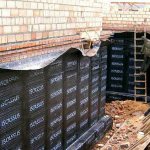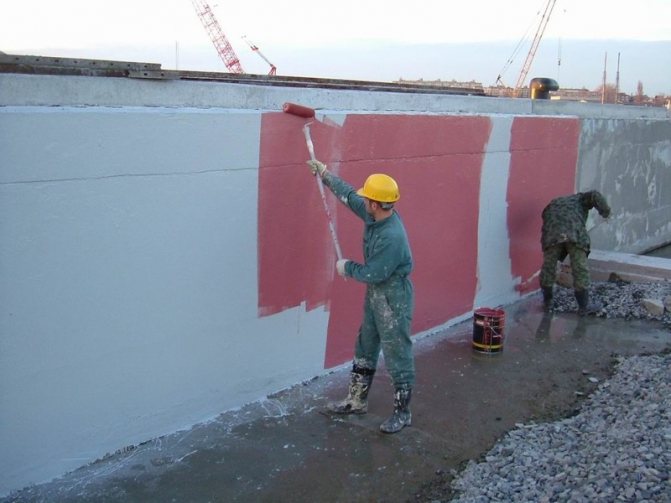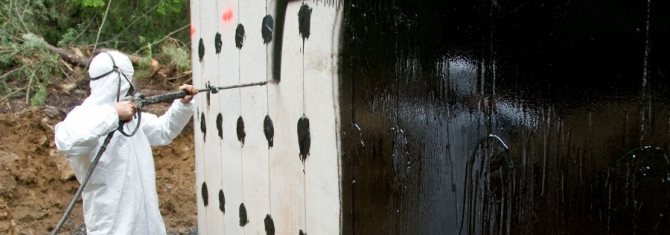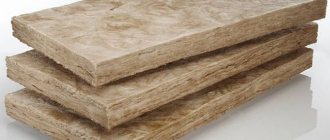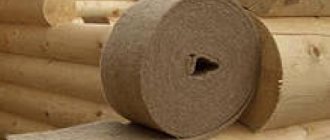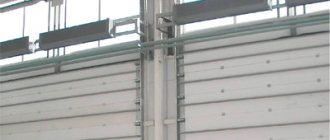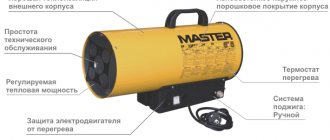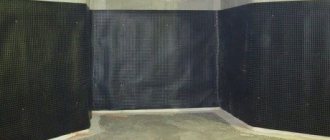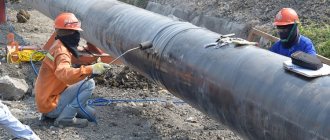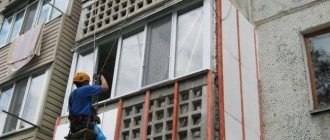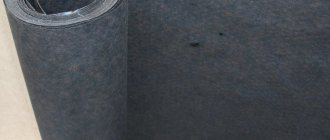Currently, construction technologies provide for waterproofing the foundation and other elements of buildings and structures (basement, basement) located below the zero mark of the facility. The waterproofing layer is made with a continuous “carpet”, in which tears are not allowed. Building structures are primarily protected from pressurized water that can seep into the building from the outside. If there is such a danger, moisture protection is arranged outside the structure. In exceptional cases, it is allowed to process the foundation and walls from inside the premises. Often this processing is done when repairing waterproofing and in already built objects.
Feature of protection of building structures from water
Waterproofing works must be carried out regardless of whether there is groundwater on the building site or not. If, during the study of the hydrogeology of the territory, the presence of groundwater is detected, it is recommended to make drainage in addition to waterproofing. So it is possible to exclude the risk of flooding the site due to seasonal fluctuations in the level of groundwater. If the water available in the soil is below the level of the base of the building all year round, this will have a positive effect on the condition of the supporting structures. But building structures are also negatively affected by atmospheric / surface waters. Therefore, the blind area around the object must be done.
Waterproofing is made in such a way that it rises along the surface of a vertical wall to a height of at least 20 centimeters. For brick and wooden structures, moisture protection rises to the foundation up to 20-25 centimeters above the ground. If the floor of the building is laid on wooden structures, then it is allowed to bring the insulation to the surface up to 15 centimeters.
The way to protect the foundation and basement of buildings can be the manufacture of their structural elements from special hydro-concrete, which includes several brands. Grades of hydro-concrete are selected depending on the characteristics of the operation of the structure. This building material can be used for the construction of port structures, swimming pools, underground bunkers, etc. Hydroconcrete perfectly withstands pressure and non-pressure water, as well as the action of aggressive chemicals dissolved in water.
Hydroconcrete is successfully used for the construction of buildings located on hills or mountain slopes. In a rainy period in such an area, the load of the soil on the foundation of the building can significantly increase and the area of contact of water with the foundation of the building object increases. Therefore, hydro-concrete in such cases allows you to solve many problems of the stability of the foundation to water and soil pressure.
There are other ways to effectively protect buildings from moisture and water, which differ in the method of applying the moisture-resistant material and the place of its application. offers waterproofing services on very favorable terms. We employ real professionals who are able to solve the most complex problems of protecting building structures from water.
Vertical waterproofing
Vertical - means waterproofing the vertical surface of the foundation. For this type of insulation, a variety of materials are used that can be combined.
There are several types of vertical waterproofing:
- waterproofing covered with roll materials;
- waterproofing with liquid rubber;
- bituminous waterproofing;
- penetrating waterproofing.
Let's consider all these types.
Pasting using roll materials
Almost all of the methods listed below can be combined with each other to achieve maximum results. The most common and simplest are gluing and coating waterproofing of foundations.
For pasting, roofing material is most often used. First, the surface of the foundation is carefully coated with mastic or primer. Then, using a burner, roofing material is applied.
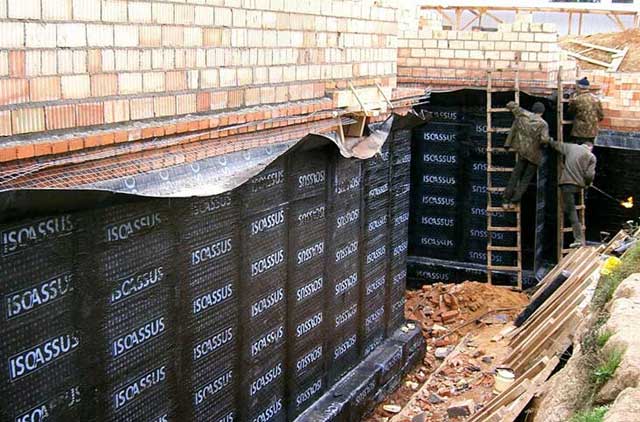
Roofing material is used most often, because it is one of the cheapest and most practical materials when waterproofing the foundation is carried out. Various kinds of isolates are also used: brizol, gidroizol, isol, gidrostekloizol, etc. There is no fundamental difference between these materials both in the method of application, in the composition and in the price. There is a new material for waterproofing STEINOPHON 290, but it is better to use it for gluing the foundation inside the building.
Liquid rubber processing
When carrying out waterproofing work with liquid rubber, it is necessary to carry out some preparatory measures:
- clean the surface of the foundation from dirt and dust;
- prime the surface;
- treat with primer or bitumen;
- apply liquid rubber in one or several layers.
The methods and features of waterproofing liquid rubber can vary greatly depending on the manufacturer, composition and modification of liquid rubber. For example, Elastopaz rubber requires several layers of application and does not require preliminary preparation of the waterproofing surface. At the same time, Elastomix liquid rubber requires priming and primer treatment.
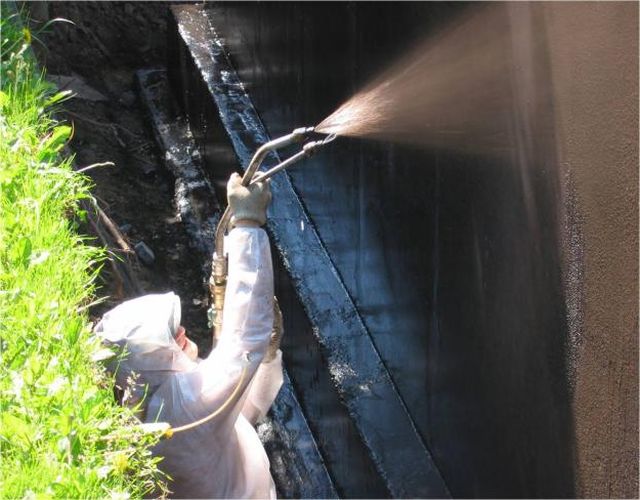

After applying liquid rubber, no seams, gaps, joints or irregularities in the waterproofing remain on the surface. It adheres perfectly to the surface, can serve for several decades and is not fire hazardous.
Coating (bituminous) foundation treatment
The most affordable option today is considered to be a coating waterproofing based on the use of bitumen. For this purpose, it is necessary to purchase bitumen, usually it is sold in bars.
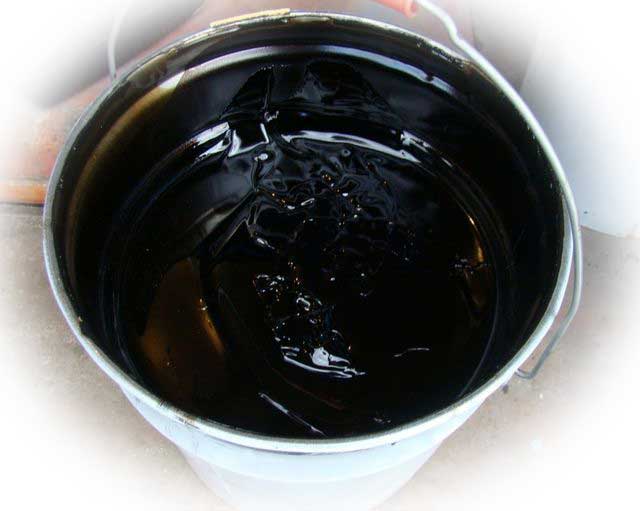

Mining and bitumen are poured into a metal container in a ratio of 30% to 70%. Next, the container needs to be heated using a diluted fire or gas stove.
It is necessary to apply 3 to 5 layers of bitumen. The resulting layer should be about 30-50 mm. During the entire application process, the composition should not cool down.


Bitumen in concrete fills all microcracks, thereby preventing moisture from entering them. Such insulation will last about 5 years, which is considered a good indicator for this type of insulation. After the declared service life, bitumen begins to deteriorate rapidly, which opens a direct path for water molecules.
To significantly increase the service of coating-type waterproofing, bitumen-polymer mastic is used. This mastic has a longer service life.
Penetrating foundation waterproofing
The principle of penetrating waterproofing of the foundation is based on the penetration of particles of the substance into the concrete and their subsequent crystallization inside. There is a kind of "clogging" of the capillaries of concrete, as a result of which the concrete is not able to pass moisture through itself.
However, penetrating waterproofing, unlike all the methods described above, has a big drawback: it is not self-sufficient. Penetrating waterproofing can only be used in conjunction with other methods of waterproofing the foundation.
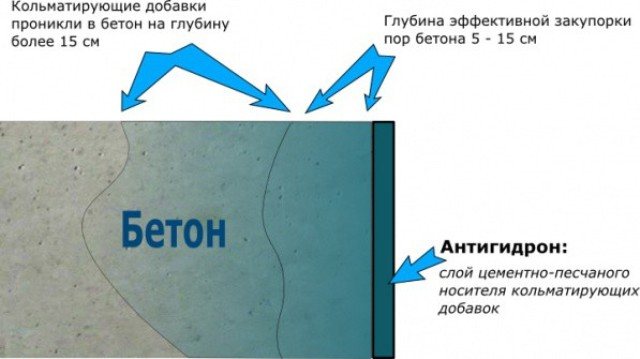

The photo below shows the principle of penetrating insulation.
Materials (edit)
Currently, the construction market represents materials for waterproofing of a wide variety of groups. All of them should be used only taking into account the characteristics of the construction site and the territory where it is located.The cost of waterproofing can vary. There are inexpensive materials, for example, bituminous mastics, and there are also quite expensive solutions. But this does not mean that preference should be given to those materials that are more expensive. It all depends on the specific conditions in which the building will be used.
Professional waterproofing works can be performed using various materials:
Basement waterproofing
The appearance of mold and dampness in the cellar or basement can be avoided by using injection waterproofing or using Penetron dry mix. Penetron penetrates the concrete structure at a distance of up to 90 cm, filling all voids, increasing the water resistance, strength and frost resistance of the structure.
For maximum efficiency, the joints and joints between the floor and the wall / wall and the wall / slab and slab are waterproofed. Before waterproofing work, these seams must be moistened.
Roll materials
- Technoelast is a multifunctional bio-resistant roofing and waterproofing material of high quality and increased reliability. It is manufactured using a unique technology by the method of double-sided application of a special insulating compound (bitumen, SBS thermoplastic or its modifications and filler) on a fiberglass or polyester base. The price per m2 of waterproofing made with Technoelast does not exceed 450-550 rubles. Materials such as sand, asbestos, etc. are used as a powder.
- Bipole is a high quality waterproofing material made on the basis of fiberglass, fiberglass or polyester. Bitumen plays the role of a binder here. The material has high strength characteristics and provides reliable surface insulation.
- Gidrostekloizol. It is made of fiberglass impregnated with a mixture of bitumen and fillers. Polymer films are used as a protective layer. It is fixed on building structures by fusion or by means of glue.
- Hydroizol. This is an asbestos canvas impregnated with bitumen. This material has excellent biological resistance.
- Metalloizol. Double-sided material based on metal foil treated with bitumen mastic. It is highly durable but short-lived.
- Folgoizol. This is the same metal insulation, only a layer of bitumen is applied to one side.
- Bikrost. The basis of this material can be fiberglass or polyester impregnated with bitumen. Protected on both sides by coarse and fine-grained powder made from sand, shale and other minerals. Distinguish between roofing and lining bikrost.
- Linocrom. Made on an organic basis with bitumen as a binder. Protected with plastic foil or mineral powder. It is used for waterproofing roofs and foundations.
There is a number of roll-bitumen materials that are easy to apply to the structure and low cost. To find out the price per m2 of waterproofing work with these materials, call the managers by phone.
How to waterproof a foundation
Waterproofing a foundation is as easy as building the foundation itself. But when waterproofing the foundation on your own, in some cases it becomes necessary to install a drainage system. A drainage system is necessary when the depth of the foundation of the house is lower than the level of groundwater flow. In addition to the emerging need for a drainage system, it is necessary to take into account the type of foundation.


For example, when waterproofing a monolithic slab foundation, a combination of traditional vertical and horizontal waterproofing is possible.It is recommended to use roll-bitumen protection reinforced with fiberglass, fiberglass or polyester as waterproofing of pillar and screw foundations. However, the proposed waterproofing options are advisory in nature.


Lubricants
The coating compositions include materials based on bitumen. Application method - cold or hot. They are characterized by good adhesion to any building structure.
Prices for waterproofing work can be found on the website, which offers various services to protect buildings and structures from surface, atmospheric and ground waters. The price for the work on applying waterproofing depends on the area of the structures to be treated and the technology for manufacturing the protective layer.
Today the specialists of our company are ready to carry out design work, as well as the installation of any kind of waterproofing. We work directly with suppliers of building materials, purchasing products at favorable prices for the end consumer. The experience of our specialists allows us to manufacture drainage and waterproofing in a short time with high quality. This is another advantage to take advantage of.
Types of waterproofing
The types of foundation waterproofing are divided into two options. In the vertical view, the external and internal walls of the foundation are processed and can be carried out even after the walls of the house have been erected. A fairly common method, which is notable for its simplicity.
When viewed horizontally, waterproofing is performed even at the stage of foundation construction.
- This laborious process is necessary on soils with a high level of groundwater and in the construction of houses from light porous materials that easily absorb moisture (wood, foam concrete, sandwich panels).
- Suitable for foundations of strip and monolithic slab type, and the most common material is roofing material.
- A layer of rolled waterproofing is horizontally applied both to the foundation tape and to the foundation wall (basement), which should be at least 20-50 cm above the soil level.
- Roofing material is laid in 2 layers on adhesive bitumen mastic and must completely cover the basement, having a small canopy on the inside.
- This ensures that there is no horizontal capillary suction of water into the wall.
- Vertical surfaces are then subject to processing.
